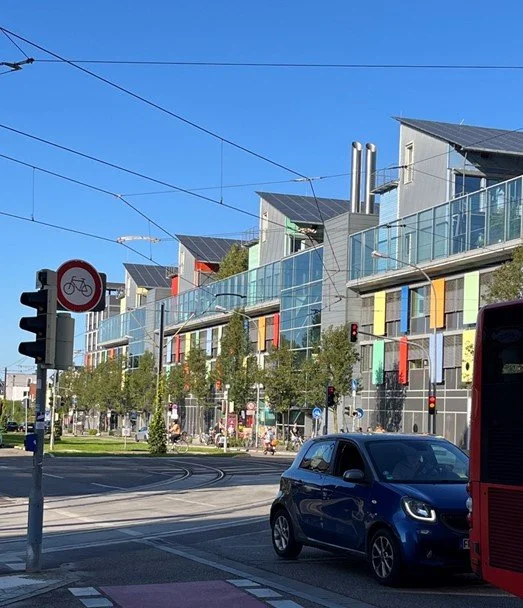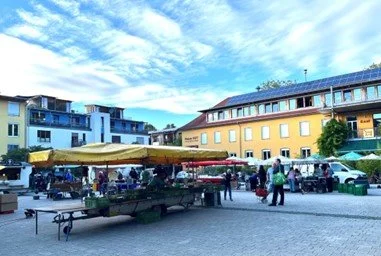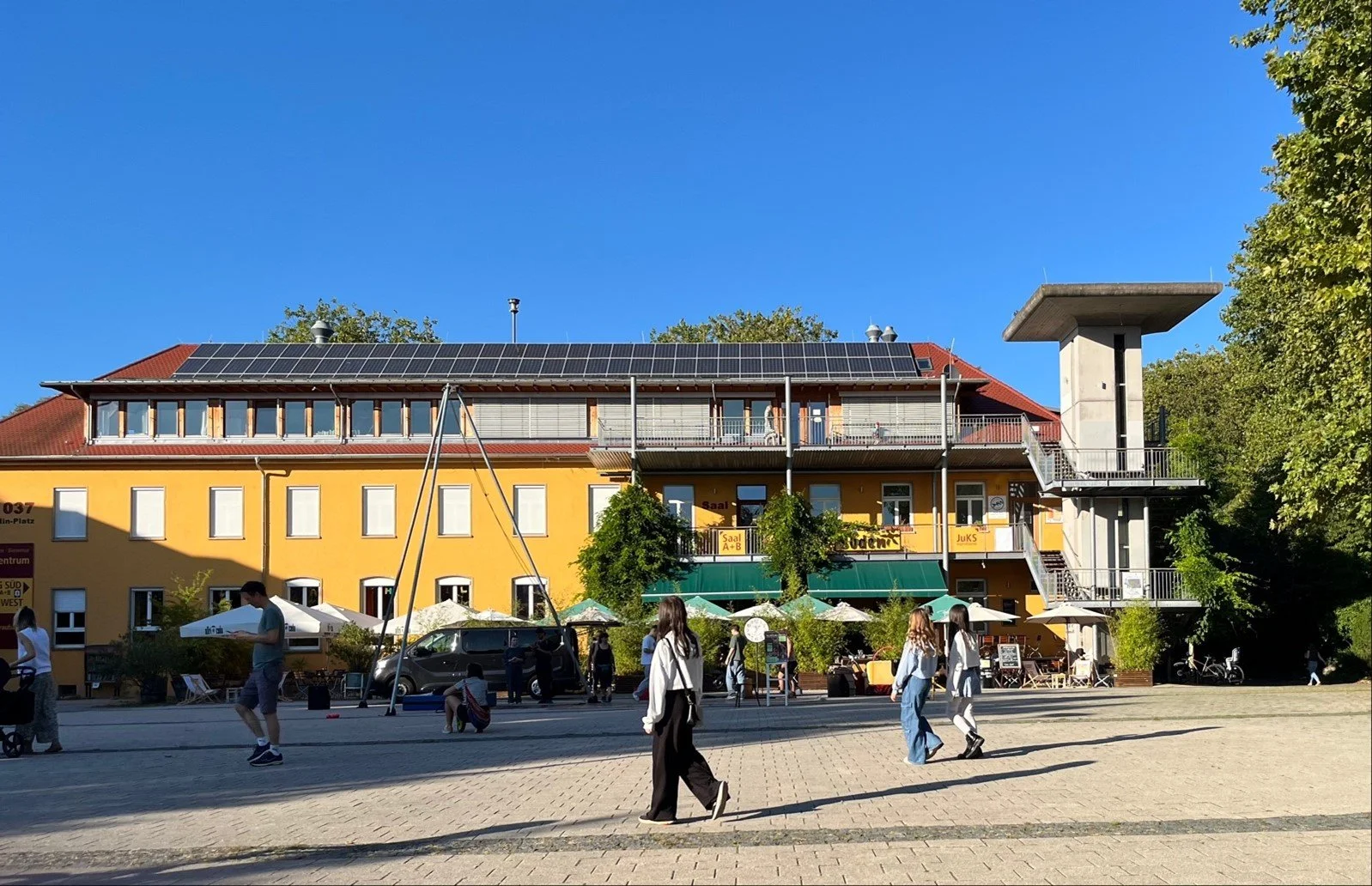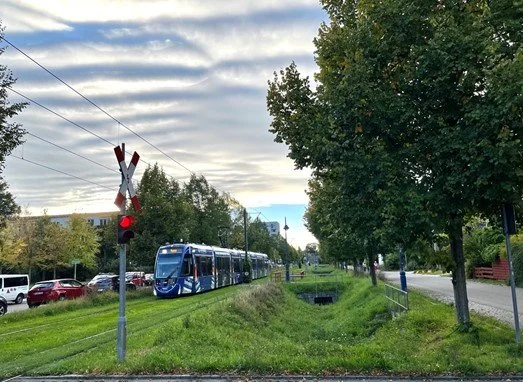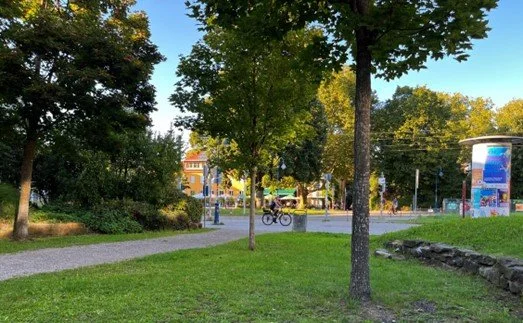Vauban, Freiburg - viewed from the street
When Phil Bixby got a text from friends John & Carol Gilham saying they were on holiday in Germany and were heading to Freiburg, his immediate response was “are you visiting Vauban?”
Vauban has long been the living example we all point to when asked about places which have been built on ecological planning principles which include very-low-car neighbourhoods - “kids playing in the street, birdsong outside your window” as spelled out in YoCo’s community plan for York Central. Along with Heidelberg’s Bahnstadt and Hannover’s Kronsberg it’s a place it would be good to experience first hand. So - next best thing:- John has done a blog of their visit, and what follows are his words and images.
On-site plan by the market place. My visit covered the bottom half of the estate, ie. the sections immediately either side of the tram track which runs from points 05 to 06 on the plan.
(The English text from the above notice can be found at the end of this blog)
This panel gives a brief history – but it’s only when you have walked through the whole estate that you find it – at the tram terminus. Note graffiti - the exception.
First impression. Mature. Open space between some blocks. Bikes parked casually.
Housing types:- Individualised. On street bike parking – presumably safe. Benches, balconies… …bin stores and bikes. Solar panels. Ubiquitous (but not so easy to photograph).
Everywhere is so green !
This is the “Sonnenschiff”, number 7 on the site plan above. Just off the main residential area, and on the main road at right angles to the spine road through Vauban. It is described as the first “PlusEnergy commercial building in the world, the Sun Ship is a shining example of the multiple use concept, combining housing, workplaces, and shops in one location”. It seems much more recent than the rest of the estate.
Play for different ages and green space for everybody. No fences separating off play equipment - just some of the many playgrounds and green spaces.
Shops: – the market square, and then many small shops on the ground floor on the main spine. Above - A Wednesday evening. Market just shutting up. Convenient for after work shopping.
Car traffic and parking on one side of the central spine only. Trams in the middle, the other lane reserved for bikes and pedestrians (though accessible for deliveries)
Local shops - The up-market and the more everyday. The new and the second-hand.
Above - This is the social centre on the market place. The restaurant is open to anyone. We can recommend it – we had dinner there. The tripod is setting up for a circus show later that evening.
Transport:- Three tram stops at the end of one of Freiburg’s numerous tram lines serve Vauban. The only stop that names Vauban is Vauban Mitte, where the red and white tram below is pausing.
Tram buffs might note that this is an elderly model, with doors on one side only. There is a loop at the end of the line to turn round and keep the doors on the platform side. 8 services per hour most of the day, 9 or 10 in the rush-hour, all night at weekends. Below - tram line, swale and footway/cycleway alongside the spine road - again note cars and parking on only one side of the spine.
Everyday details:- shared foot/cycle way, bike hire station, car sharing and charging points…
…and amenities - dentists, recycling, a book swap (a Freiburg-wide initiative), and a very green hotel…
…and (below) a “solar garage”!! - for residents and visitors. (Editor’s note:- residents who live in Vauban who wish to own a car are required to declare this and to buy a parking space in one of the two multi-storey car parks on the periphery at a price that reflects its actual cost - between €18,500 and €22,500 and the maintenance costs are about €70 per month. The residential street network allows vehicle access to all homes, but cars must be parked in the car parks).
Above - a primary school and two buildings directed to services for children - one is a kindergarten – possibly to encourage toddlers to live adventurously.
…and some miscellany:-
Roadside red box, a place admirably tolerant of wild flowers and spreading greenness, and not very much graffiti, but some.
From the history panel at the start of this blog:-
“Urban development boasting ecological awareness and excellent citizen commitment:- Covering an area of 41 hectares, Vauban was built on a former barracks site that was occupied by the French military up until 1991. Committed residents played a significant role in driving forward this vision, which resulted in the founding of the Forum Vauban in 1994. The Stadtteilverein Vauban e.V. has been supporting citizen participation and neighbourhood work since 2005. Both associations have been and continue to be influential in shaping the sustainable district. As a result, the planning process was expanded to include important ecological and social topics, such as reduced-traffic areas, creating a district with everything nearby as well as prioritising private building groups and cooperative residential projects over developers and investors. The forum and district association also campaigned to preserve a central building which, after much dedication and effort, was finally developed into House No. 037- Freiburg's first self-managed community centre.
Active neighbourhood with a diverse range of living accommodation:- The residents possess remarkable community spirit and social commitment. Good neighbourly and urban relations help to shape the district's open culture, which is further promoted by social and cultural activities. Vauban's planning process, which scrapped design regulations in the land-use plan and provided a wide range of different plot sizes, played a particularly important role in achieving the active neighbourly relations and district we see today. The planning process created a diverse mix of individual building projects, groups of building owners, rented and owner-occupied flats, cooperative models as well as inclusive accommodation projects that promote social integration such as Genova, the Green City Hotel and VAUBANaise. Ten former barrack buildings have been converted into affordable housing by the City of Freiburg Student Union and the S.U.S.I.-project, or "self-organized, independent neighborhood initiative". Thanks to the social infrastructure, it's possible to locate workplaces and housing within short distances of one another. The district boasts a community centre, nurseries, a primary school, cafés and restaurants, shops to cover day-to-day needs as well as innovative projects, such as VillaBan and DIVA, which unite service providers, arts and crafts under one roof.
Energy and the environment for a high quality of life:- In addition to fulfilling Freiburg's low energy building standard (65 kWh/m²), the majority of passive houses have a maximum energy consumption of 15 kWh/m². The Kleehäuser zero-energy houses as well as the PlusEnergy Solar Settlement and Sun Ship are all unique, as they produce more energy than they use. The district's heat is supplied by a combined heat and power plant, which also joins forces with numerous photovoltaic installations to supply electricity to households. As Vauban is a densely built-up district, incorporating green areas for relaxation and recreation into the planning was particularly important. This allowed most of the existing trees to be preserved and new plants to be added. Residents played a key role in planning the five green areas with different themes, which have been designed to use slope wind to help circulate air around the district. The high quality of life that the district offers can also be attributed to the green roofs stipulated in the land-use plan, the nature reserve neighbouring Dorfbach, St. Georgen, and the Schönberg and Schlierberg hills.
A district with a sustainable environmental policy where everything is nearby:- The concept of a district with reduced-traffic areas has been proven successful by the extremely low number of 172 cars per 1,000 residents - considerably lower than everywhere else! This low number is due to the variety of shopping possibilities and services on offer within walking distance. Car ownership is made redundant for many people thanks to the tram and bus links, good cycle paths and abundant numbers of car sharing vehicles, and has prompted 430 households to seize the opportunity of car-free living. As partners of the Verein für autofreies Wohnen e.V. (association for car-free living), each of these households has made a one-off contribution to finance an area reserved for a car park. Those living in car-free play streets but who do not wish to be entirely “car-free" can use the reduced-traffic area for loading and unloading purposes and then park in one of the district's car parks. This ensures that the residential streets are used as meeting places and remain safe for children to play on. Visitors can make use of the 200 public parking spaces located in access roads, while car sharing users can park in one of 30 dedicated spaces located around the district.”
We sat here in the evening light, just off the main spine opposite the market place, for about 20 minutes. I didn’t count the pedestrians nor the many bikes in all their variety but in that time no more than 5 cars passed.
Vauban is certainly an inspiration, seen from the street. Physically, a modern but already mature suburb. It’s difficult to read a place socially, economically or politically in the course of a few hours visit, especially as a foreign outsider, but it appeared to be a genuinely mixed and thriving community, with lots of young families, most of the facilities a community needs, and excellent access to the city centre. It didn’t seem at all isolated from the surrounding area. (Also a warm autumn evening showed it very favourably.)












